CREATING A NEW SMILE
In this day and age, patients are seeking more than just a cleaning or cavity treatment at a dental practice.
Three steps:
1- Identify
2- Visualize
3- Choose
The way this is done is to first consider what the patient is seeking: esthetics.
The second part to this approach is to think of the structure�function�biology in the context of an ideal esthetic vision.
We do this by first performing a diagnostic wax-up on a mounted cast, which would be guided by the Esthetic Evaluation Form. This form will be analyzed during the consultation appointment, and it will allow me to diagnose and assess both the esthetics and function at the same time. It is a systemized method for determining exactly where the esthetics need to be changed in a given case. It will eliminate errors, miscalculations and miscommunication.
� *the main objective of this form for me as a dentist, is to establish the incisal edge position, and the gingival margin of the maxillary central incisor, which will be used to design the entire case.
� This form will also give me more detailed knowledge and pinpoint the true esthetic needs of the patient.
� We analyze the facial esthetic elements first (macro-esthetics) and follow the dentofacial assessment and, finally, study the dental view (micro-esthetic elements).
And by doing this, we can accurately visualize what the patient�s smile will look like after an esthetic restoration.
We will be able to visualize tooth position, shape, and the soft tissue surrounding them. This would allow us to receive crucial feedback from the patient as well.
Our reason for success is a great teamwork between the patient, the dentist and the technician. It�s is not only attributable to the technical nature involving the restoration.
This is where our note-taking comes in handy. We become an empowered team, and we can co-create the esthetic vision together.
Part 1: effective questions:
If there was anything you could change about your smile, what would it be?
We want the patient to be involved in the process by creative communication right from the beginning, and we can build a strong relationship that is focused on effective communication, and success.
At this point, we must establish the patietn�s preference at this early stage.
We ask them, Do you like the visual image of:
� �straight, white and perfect�,
a symmetrical smile where the right and left sides are mirror images and all teeth are a very light shade and in perfect alignment. We like to offer a picture of the actress Halle Berry, someone everybody knows whose smile is a great example of this.
� �clean, healthy and natural�
having the perfect imperfections of nature: slight rotations and/or setbacks of the lateral incisors, slightly irregular incisal edges and a more natural shade. The actress we refer to for this description is Sarah Jessica Parker.
� �white and natural�?�
. This implies natural tooth forms but in a light shade, exemplified by the smile of Julia Roberts. At the time of this publication, the majority of patients seem to prefer this final category as preferences have shifted away from the �Hollywood� smiles of the 1990s towards a less artificial look. But again, beauty is extremely subjective and so the patient�s desires need to be determined early on.
We will then ask you if there are any relevant photos of the patient or of any other smiles you admire.
C L I N I C A L T I P The importance of the questions in this section cannot be overemphasized, as the entire case will be designed according to the ideals of the patient and not those of the dentist or the laboratory technician.
The next step of the appointment would be facial, dentofacial and dental analysis according to the Evaluation Form:
We would move from the facial view (full face) to the dentofacial view (teeth and lips) and only then assess the dental view (retracted smile). Each view has important esthetic elements to review as we move through our diagnosis.
MACRO-ELEMENTS:
Facial view:
What I look for in the facial view is balance and harmony, or a lack of tension in the composition of the face. This is done by first looking at the frontal view with a full smile and taking two orthodontic measurements from the profile view with the patient in repose.
When the patient is in repose:
Create parallelism between interpupillary line and the line corresponding to the occlusal plane. We are looking to determine any canting of the maxilla�. Clinically a length of floss can be used to visualize this.

The location of the facial midline in relation to the maxillary dental midline. This too can be visualized clinically with floss.�������������������������������������������������������������������������������������������������������������������������������������������������������������������������������������������������������������������������������������������
Lip anatomy. This is viewed in terms of symmetry to the face and fullness of the upper and lower lips. We also assess how prominent or retruded the lips are, from a profile view. The degree of lip support helps determine if the case should be �built out� facially or not.
Tooth exposure at rest.
� This decrease in maxillary central display is due to the loss of muscle tone over time, gravity and wear of the incisal edges.
� Lengthening the incisal edges of our patients� teeth will thus result in a more youthful appearance.
� To assess the amount of tooth display at rest, we ask our patients to relax their lips, say the word �Emma� and then freeze (Fig. 1.7).
� this is the first step towards determining the existing incisal edge position of the tooth to the lips and face. SEE EVALUATION FORM
Nasolabial angle: an orthodontic measurement assessed from a profile view of the patient with the lips in repose.
� strive for a nasolabial angle of 90�
� an angle of less than 90� (prominent maxilla) means the maxillary anterior restorations should be smaller and less dominant, while an angle of greater than 90� (retruded maxilla) means the patient can afford to have their maxillary anterior restorations �built out�.
Ricketts� E-plane.
A second orthodontic measurement, also assessed from a profile view, describes the imaginary line drawn from the tip of our patient�s nose to the chin.
we can utilize a length of floss held against these two facial landmarks and measure with a periodontal probe.
Ideally, the upper lip is 4 mm from the E-plane and the lower lip is 2 mm away.

If the upper lip is greater than 6 mm from the plane then we consider this a concave profile
If the lips are on the plane then there is more of a convex
profile.
In nature, a maxillary central incisor can be anywhere from 10 mm to 12.5 mm long, and it is appropriate to design maxillary centrals towards the larger end of this range for the concave patient and towards the smaller end of this range for those who are more convex.
As a rule of thumb, for the convex patient with a high smile line,
the length of the maxillary central should not exceed 10.5 mm.
Dentofacial view
This view (Fig. 1.11), comprising of the teeth and lips, deals with the vertical and horizontal components of the smile. We ask for a full, natural smile and assess the amount of gingival display (as a �high smile line� case will be inherently more challenging).
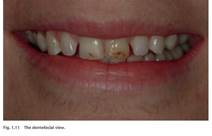
We observe the degree to which the incisal edges of the maxillary anterior teeth echo the curve of the lower lip, count how many teeth show in the smile and check for the presence of excessive negative space bilaterally.
The position of the facial midline in relation to the maxillary dental midline is noted. We know from Kokich�s study7 that the midline can be �off � up to 4 mm in either direction and will still be inoffensive to the layperson�s eye. According to that same study, however, a midline cant is extremely noticeable to most people and thus a higher priority to correct.
Phonetics are addressed as well in this part of our diagnosis. We observe the closest speaking space and listen for any lisping as the patient pronounces �S� sounds (Fig. 1.12). Next �F� sounds are pronounced and we look for the incisal edge of the maxillary centrals to just brush against the wet/dry line of the lower lip (Fig. 1.13).
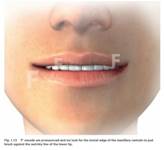
The lip should not seem to �reach� for that incisal edge (tooth too short) nor should the tooth �trip over� the lower lip (tooth too long). Note that the �F� sounds should be pronounced GENTLY, as a forceful pronunciation will recruit the muscles of the lips and give an inaccurate read.
The letter �E� should be pronounced as well, as this mimics a wide smile and is useful to observe.
Dental view: Occlusal analysis and micro-elements
With the dental view (Fig. 1.14) we begin by evaluating the patient�s occlusion. We then assess the balance between the �white zone� (the teeth) and the �pink zone� (the gingiva) and consider 16 specific micro-esthetic elements.
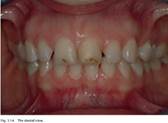
� The fundamentals of occlusion can be defined as a mutually protected occlusion.
� the front teeth separate the back teeth in all directions without interference (�anterior coupling�)8 and the back teeth support the front teeth in a vertical direction. This beautifully designed relationship works extremely well, as it minimizes premature contacts and interferences that would cause wear and trauma to the whole system.
� Any interference with complete occlusion, protrusive, and right and left working is identified with articulating paper and noted on the form.
� We also note which teeth provide guidance in the working positions, whether it is canine guidance, premolar guidance or a �group function� scenario.
remember that the palatal contour of the maxillary central incisor defines anterior coupling, the incisal edge defines phonetics and the facial surface defines esthetics (Fig. 1.15). All three surfaces must be considered, as oftentimes a veneer scenario becomes full coverage once the tooth�s lingual contours are assessed.
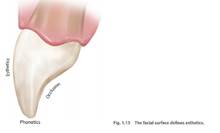
Micro-esthetic elements
We now turn our attention to the final section of the Esthetic Evaluation Form, the micro-esthetic elements. By analysing these elements we can clearly identify the necessary changes to be incorporated into our diagnostic wax-up:
� Incisal edge position. The position of the maxillary central�s incisal edge as it relates to phonetics, function and esthetics. Remember once more that the position of the maxillary central incisor is the most critical aspect of the smile. Once we know where this tooth�s gingival margin goes and where the incisal edge needs to be positioned then everything falls into place; the height of that tooth defines its ideal width (roughly 80% of the height, as we know from various studies) and simple biometric guidelines then provide the widths of the other teeth.4,5 Ideally, the edges of the maxillary central incisors and the points of the canines lie on the same horizontal line, with the lateral incisors� edges set above this line (Fig. 1.16).
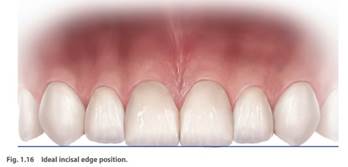
Soft tissue symmetry. The gingival height of the maxillary centrals and canines should ideally be at the same level, with that of the lateral incisors being 1.0�1.5 mm below this line (Fig. 1.17). This is especially critical in the high smile line patient.

Trigonal shapes. The peak of the gingival seam is highest at the distal aspect of the maxillary central incisor, approximately 1 mm distal to the tooth�s midline (Fig. 1.18). This is often described as a �gull-wing� effect. The zenith point of the laterals and canines, however, should be centred mesiodistally.10
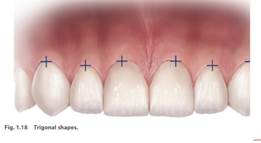
Axial inclination. The six anterior teeth have their roots distally inclined, with the centrals being the closest to upright and the inclination increasing as we move distally (Fig. 1.19A,B).9 This subtlety reflects the position of the underlying roots, as no two structures can occupy the same space.
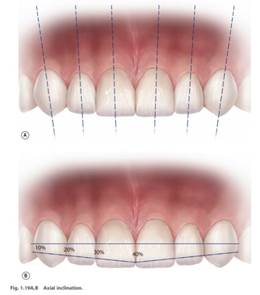
Tooth proportion. The width of the maxillary central incisor should be 75�85% of its height (Fig. 1.20).

C L I N I C A L T I P One of our rules for the high smile line patient is never to exceed 10.5 mm for the height of the central incisor, as this would create an imbalance in the lower third of the face.
Tooth-to-tooth proportion (Fig. 1.21). The latest biometric study from Dr Stephen Chu shows that if the central incisor�s mesiodistal width is X mm, then the lateral should measure X−2 mm and the canine should be X−1 mm.11 Note that X−1 should account for the entire mesiodistal width of the canine, versus the traditional golden proportion approach that only accounted for the mesial half of this tooth.
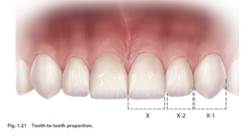
Line angles (Fig. 1.22). The contour ridges, or line angles, give the outline form to the teeth. Adjusting the line angles of a tooth can make it appear wider or narrower.
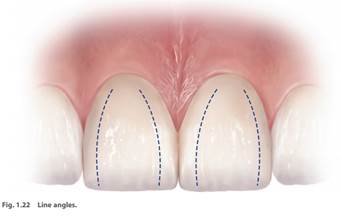
� Height of contour (labial view). The height of contour should be distal to the midline at the gingival third (Fig. 1.23).
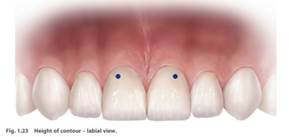
� Papilla proportions (Fig. 1.24). The papilla occupies 40% of the space from the contact area to the cemento-enamel junction of the central incisors and stays consistent in this volume from central to lateral to canine.
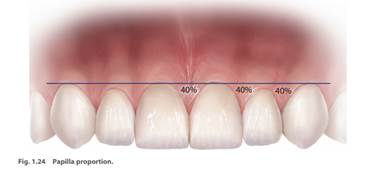
Contact area (Fig. 1.25). The contact area between the centrals starts at 40% of the height of the tooth and decreases to 30%, 20% and 18% as we go from the central to the lateral to the canine, and then to the distal of the canine.13
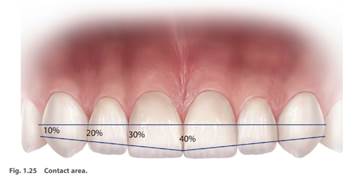
Incisal embrasures (Fig. 1.26). Between the central incisors the embrasure space makes up 20% of the tooth�s height. This increases to 25%, 30% and 35% as we move distally.13 Abrasion and wear cause the incisal embrasures to disappear over time, and so recreating these embrasures will give our patients a more rejuvenated look.
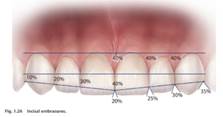
Texture (Fig. 1.27). This shows where the lobes of the tooth are formed in development and occurs in both a vertical and horizontal direction. It is an element that gives the tooth a more natural look and we must ask whether the patient desires this.
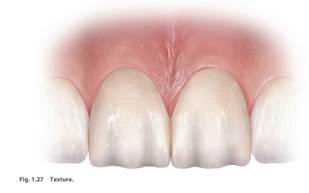
� Height of contour (incisal view) (Fig. 1.28). This vantage point shows that the maxillary central�s height of contour is distal to the tooth�s midline.
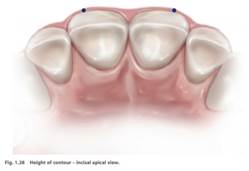
Profile view. This view shows that there are three planes of the tooth from the cemento-enamel junction, through the body of the tooth, to the incisal edge (Fig. 1.29).
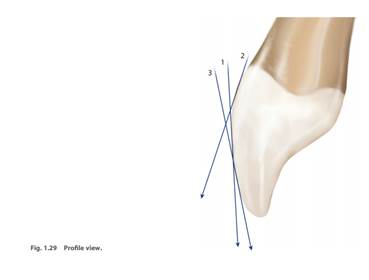
Parallel of curves (Fig. 1.30). The contact points, incisal edges and lower lip should form three curves that echo one another harmoniously.
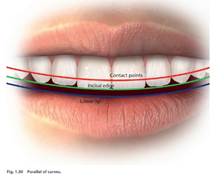
Incisal edge contour (Fig. 1.31). A 3-dimensional edge on the anterior tooth creates a natural appearance. The edges of worn anterior teeth have well-defined buccal and lingual incisal line angles, and these contours can be emphasized or minimized depending on our esthetic goals.
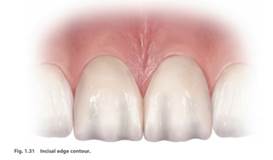
We indicate, on the form, whether each of these elements is acceptable or not in the existing dentition, and if not our planned improvements are described. By becoming comfortable in this language of micro-esthetics we can communicate meaningfully with our lab technician, and little is left to the imagination.
Records
it is beneficial to take all photographs after completing the form, as the clinician will be more aware of what each shot should capture. . �The eyes�, as they say, �don�t see what the mind doesn�t know.�
|
Facial
full smile, normal smile and repose. |
|
|
|
|
|
Oblique full smile, (B) normal smile and (C) repose. |
|
|
|
|
|
Lateral Lateral facial photos: (A) full smile, (B) normal smile and (C) repose. |
|
|
|
|
|
Dentofacial- frontal full smile, (B) normal smile and (C) repose (�emma�). |
|
|
|
|
|
Dentofacial- oblique Oblique: (A) full smile, (B) normal smile and (C) repose. |
|
|
|
|
|
Dental retracted views |
|
|
|
|
|
|
|
|||
|
|
|
|||
|
|
|
|||
Djflhghghghhgg
Hiiiii byeee










